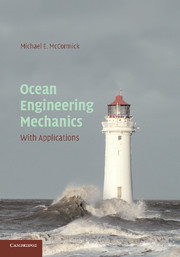Book contents
- Frontmatter
- Contents
- Preface
- Notation
- OCEAN ENGINEERING MECHANICS
- 1 Introduction
- 2 Review of Hydromechanics
- 3 Linear Surface Waves
- 4 Nonlinear Surface Waves
- 5 Random Seas
- 6 Wave Modification and Transformation
- 7 Waves in the Coastal Zone
- 8 Coastal Engineering Considerations
- 9 Wave-Induced Forces and Moments on Fixed Bodies
- 10 Introduction to Wave-Structure Interaction
- 11 Wave-Induced Motions of Floating Bodies
- 12 Wave-Induced Motions of Compliant Structures
- Appendices
- References
- Index
3 - Linear Surface Waves
Published online by Cambridge University Press: 05 June 2012
- Frontmatter
- Contents
- Preface
- Notation
- OCEAN ENGINEERING MECHANICS
- 1 Introduction
- 2 Review of Hydromechanics
- 3 Linear Surface Waves
- 4 Nonlinear Surface Waves
- 5 Random Seas
- 6 Wave Modification and Transformation
- 7 Waves in the Coastal Zone
- 8 Coastal Engineering Considerations
- 9 Wave-Induced Forces and Moments on Fixed Bodies
- 10 Introduction to Wave-Structure Interaction
- 11 Wave-Induced Motions of Floating Bodies
- 12 Wave-Induced Motions of Compliant Structures
- Appendices
- References
- Index
Summary
Ocean waves are caused by the motions of celestial bodies, seismic disturbances, moving bodies, and winds. The waves produced by these phenomena differ in size and character, and the consequences of each must be dealt with differently.
The gravitational attractions of both the moon and the sun cause the largest water waves, called the tides. The predictable tidal wave can be treated as a shallow-water wave because its length is much greater than the water depth. Extreme tides, called spring tides, occur when the attractive forces of both the moon and sun are aligned and in the same direction. These tides can cause flooding of lowlands if dikes or levees are not present. The tides can also be exploited by converting their energies into useable energy forms. This is normally accomplished by creating tidal barriers equipped with hydroturbines, taking advantage of the tidal-induced water level changes on opposite sides of the barriers. An excellent book on tidal energy conversion is that written by Charlier (1982).
Both sub-marine earthquakes and volcanic eruptions can produce a long, high-energy wave called a tsunami (the Japanese word for a tidal wave, although the wave referred to is not tidal in nature). This type of wave can pass a ship in the open ocean and not be noticed by the ship's crew because of the small wave height-to-wavelength ratio (called the wave steepness). As the tsunami approaches a land mass, the energy of the wave is transformed from mostly kinetic to mostly potential.
- Type
- Chapter
- Information
- Ocean Engineering MechanicsWith Applications, pp. 44 - 72Publisher: Cambridge University PressPrint publication year: 2009



